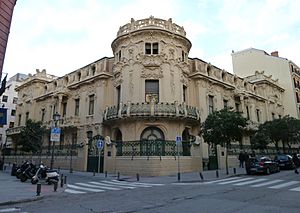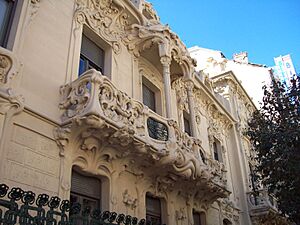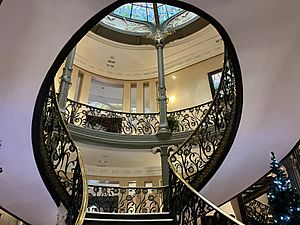Longoria Palace facts for kids
Quick facts for kids Palace of Longoria |
|
|---|---|
| Native name Spanish: Palacio de Longoria |
|
 |
|
| Location | Madrid, Spain |
| Built | 1902-1904 |
| Architect | José Grases Riera |
| Architectural style(s) | Art Nouveau |
| Official name: Palacio Longoria | |
| Type | Non-movable |
| Criteria | Monument |
| Designated | 1996 |
| Reference no. | RI-51-0009569 |
| Lua error in Module:Location_map at line 420: attempt to index field 'wikibase' (a nil value). | |
The Palace of Longoria (in Spanish: Palacio de Longoria) is a beautiful building in Madrid, Spain. It was built in the Art Nouveau style, which was popular in the early 1900s. A rich politician and banker named Francisco Javier González Longoria asked for it to be built.
The palace is located in the Chueca area of Madrid. You can find it where Fernando VI and Pelayo streets meet. It is one of the best examples of Art Nouveau architecture in Madrid. Another famous building in this style is the House of Gallardo in Plaza de España.
Longoria hired a talented architect named José Grases Riera from Catalonia. He designed and built the palace between 1902 and 1904. In 1996, the Palace of Longoria was recognized as a special historical monument. Today, it is the main office for the Sociedad General de Autores y Editores (SGAE). This is an important group that protects the rights of artists and writers in Spain.
Contents
What is Art Nouveau?
Art Nouveau is a unique art style that was popular from about 1890 to 1910. It means "New Art" in French. This style often uses curvy lines and shapes inspired by nature. Think of flowers, plants, and insects.
Features of Art Nouveau Buildings
Buildings in the Art Nouveau style often have:
- Fancy decorations
- Curved windows and doors
- Colorful glass or tiles
- Designs that look like vines or leaves
The Palace of Longoria shows many of these features. Its balconies and details are great examples of this style.
Who was Francisco Javier González Longoria?
Francisco Javier González Longoria was an important person in Spain. He was a politician and a financier.
- A politician is someone who works in government. They help make decisions for the country.
- A financier is someone who deals with large amounts of money. They might invest money or help businesses.
Longoria wanted a grand and modern home. So, he chose the new Art Nouveau style for his palace.
The Architect: José Grases Riera
José Grases Riera was a well-known architect from Catalonia, a region in Spain. He was born in 1854 and passed away in 1919. He designed many important buildings during his career. The Palace of Longoria is one of his most famous works.
Riera's Design for the Palace
Riera designed the Palace of Longoria to be both beautiful and useful. He used many Art Nouveau elements. These include the detailed balconies, the curved windows, and the overall shape of the building. The palace has a grand central staircase inside. It connects the different floors with elegance.
A Protected Monument
In 1996, the Palace of Longoria was named a Bien de Interés Cultural. This Spanish term means "Property of Cultural Interest." It is a special title given to important historical or artistic sites in Spain.
- When a building gets this title, it means it is protected by law.
- This helps make sure the building is kept safe and preserved for the future.
- It shows how important the Palace of Longoria is to Spain's history and art.
The Palace Today
Today, the Palace of Longoria is home to the Sociedad General de Autores y Editores (SGAE). This organization helps artists, musicians, and writers. They make sure these creators get paid for their work. It's a fitting use for a building that is itself a work of art.
See also
In Spanish: Palacio Longoria para niños



